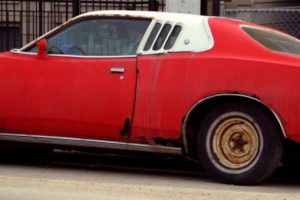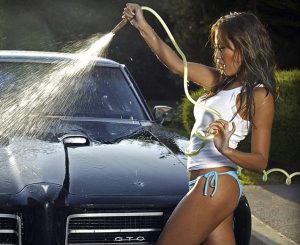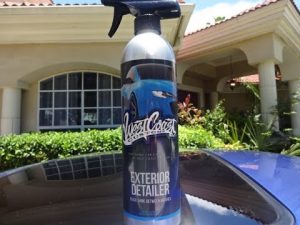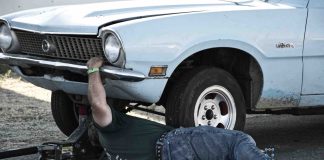Back in high school chemistry, you may have heard the teacher refer to water as the universal solvent.
Exactly so. It dissolved a mile of rock at the Grand Canyon, for instance.
And it will eventually dissolve your car, too.
Your old car, especially.
This bears some defining, though.
A fifteen-year-old car is an old car – but it’s not an old car for purposes of this discussion. No car built during the past 30 years or so is really an old car, nor will ever be one. Not in the sense that matters.
Which is the build quality/body integrity and rust-protected sense.
Cars built since about 30 years ago – ’90s and up – are almost hermetically sealed against the intrusion of water into places where it will foment rust. Their panels usually fit tightly and precisely.
As a result, they rarely leak. And if they do, the metal is generally better able to withstand the Ancient Enemy . . . rust.
On the other hand, cars built prior to 30 years ago – anything made earlier than the ‘80s – are typically rust traps. They have gaskets that didn’t fit very well and so leaked when new, letting water rivulet into places like the inner rocker panels and trunk – where it does to your car exactly what the Colorado River did at the Grand Canyon.
They have trim that seemed designed to catch and retain moisture, the grossest offender being windshield molding. Their sheetmetal was poorly aligned, insouciantly rustproofed, shoddily painted and easily chipped – exposing the raw, unprotected metal.
Get them wet and they will rust.
And rust faster.
That’s probably the main reason why you don’t see them around much anymore. It’s the real planned obsolescence. Engines in those old cars can can be rebuilt fairly easily – and pretty cheaply. Rusted bodies and frames are the opposite. Welding in new metal is hard – and expensive. Body and paint work isn’t cheap.
But how to keep an old car clean if you don’t use water to wash it?
If you’ve been to an old car show you probably already know the answer. It is to use a spray detailer and a soft, clean cloth rather than a garden hose and sponge.
The advantages are several.
First, you’re not using water – which isn’t formulated to protect your car’s finish. Tap water can actually stain your finish if it’s pH unbalanced, lime-laden, too alkaline or acidic. And especially if you wash the car with it in the hot sun, where it acts like a magnifying glass, focusing the sun’s radiation like Dr. Evil’s laser bream, leaving liver-spotted fade/burn spots in its wake.
With the spray detailer, you can work on one panel at a time – and not have to worry about water boiling off the parts of the car you couldn’t dry off in time. It’s also pH-balanced, specifically made for the job at hand. Formulated to not hurt the finish. Or remove wax.
Second, you can’t control water.
Use a hose and water goes everywhere. It will get everything wet – not just the parts of the car you want to wash off. It will seep into the channels behind trim and moldings, drip into dark places inside the trunk, behind the door panels, inside the rocker panels. Which is like feeding a teenager a six-pack of Red Bull.
A reaction will ensue.
You could take the car for a long drive to air it out, post-wash. And that will definitely help. But water is recalcitrant and persistent. There are places that airflow doesn’t reach.
If there was any rust in those dark, hidden places, getting those places wet will accelerate the rusting process.
And if you don’t take the car out for a long drive to air it out – and just roll it back in the garage after a wash – all that moisture will help rust take hold in places not yet rusty but soon to be.
With the spray detailer, you avoid all of that.
No worries about accelerating your rust woes. If you start with a completely rust-free car, it may never rust. Regardless, the drier you can keep your old car, the more slowly it will rust. My ’76 Trans-Am has sone slight surface rust along the edges of the rear windshield molding – a common place for rust to begin on these cars. But it’s still free of Swiss Cheese and looks damned good – including its mostly original paint – because I keep it dry by rarely washing it.
It is sound policy.
. . .
Got a question about cars – or anything else? Click on the “ask Eric” link and send ’em in!
If you like what you’ve found here, please consider supporting EPautos.
We depend on you to keep the wheels turning!
Our donate button is here.
If you prefer not to use PayPal, our mailing address is:
EPautos
721 Hummingbird Lane SE
Copper Hill, VA 24079
PS: EPautos magnets – they’re back! are free to those who send in $20 or more to support the site. Also, the eBook – free! – is available. Click here. Just enter you email in the box on the top of the main page and we’ll email you a copy instantly!












EMP’s did occur with testing which is why they’ve morphed into a weapon of modern war. Las Vegas went suddenly and mysteriously dark after an above ground test. That’s how things got started. Later parts of Hawaii went dark during low space nuclear testing. Old electronics were much more robust than modern millivolt operating systems. Weapons can be configured to yield more EMP and a big one 200 miles above the center of the country would pretty much annihilate every device we have.
K
Western Pennsylvania got to be one of the worse places for rust. Last week I had a class three trailer hitch literally fall off my truck hanging from the wire harness. Frame on the old chevy pickup has surface rust but no holes. The salt on these Pittsburgh roads eats metal alive. Just saying.
As a side note- if you wash a motorcycle, water can get in your motor around the exhaust pipe. You need to run and warm that motor up to make sure it doesn’t sit on your exhaust valve seal.
Spray detailer is OK, but Optimum No Rinse I would argue is even better. ONR even makes a version that is wash-n-wax if you’re too rushed to wash and wax separately.
ONR is a rinseless polymer soap. Dilute it in a small volume of water. Then you wipe it on with a microfiber, soak up the dirt, then wipe the panel dry with a clean microfiber. Done. Move on to the next panel. The polymers encapsulate the dirt so that it doesn’t scratch your paint and no rinsing is necessary.
I think a climate controlled garage is the only real way here in the rust belt. I’ve seen cars rust more in one year sitting in an unheated garage the 30 yrs in a heated one. Even without rain, the condensation caused by temperature changes forms on all the metal surfaces. Even a winter car doesn’t rust nearly as bad if kept inside.
The key is the absence of water, the primary requirement for unprotected steel to rust.
‘… INSOUCIANTLY rustproofed …” You’ve been reading too much Paul Craig Roberts.
You have been marinating in his vocabulary for too long.
Boy howdy. I must have a hundred hours on body work for my 66 F100. And it needs another round already.
10 hours replacing the engine and tranny – and this time I put a tbi dodge where I had to redo the engine mounts and bring the entire wiring harness and computer along with.
I use this on my bikes and will start using it on my truck too.
https://www.amsoil.com/shop/by-product/other-products/cleaners-and-protectants/miracle-wash-waterless-wash-and-wax-spray/
Bad thing is, I have no room in my garage and my barn is 200 yards away from the house. So it sits in the rain 🙁
Good advice! I wash and wax my old Charger once a year. It’s garage kept and the 2006 paint job still looks mostly new, except where things from the road hit it, or ass hats rub against it at the shows.
I lived in Cali for 32 years, drove old cars and never had rust issues no matter whether I washed them or not. Moved to Ohio in ’07, bought a ’07 and it wasn’t too long before rest formed on the rear fenders. Those silly factory plastic fender trim pieces that wrap around the fender’s wheel opening are bound to trap water, dirt and salt and prevent ventilation. Don’t like ’em.
A body shop owner back in the 70s told my Dad to shoot motor oil up into the fenders, quarter panels, and rocker panels, all of those places were rust starts. I do that on my old cars, and it seems to at the very least slow down the rust process. Sometimes, I have oil dripping from the car, but excess oil won’t destroy it.
As long as it doesn’t wind up on rubber parts, like tires.
I can’t remember ever washing all of any vehicle I have owned.
I helped a young man repair the starting system in his 1972 Ford pickup yesterday, which was well rusted, but rust is self-sealing and stops with a secession of encouragement. The vehicle’s integrity was unimpeded.
Aww, she don’t know what she’s doin’….
On the contrary, boys, she knows EXACTLY what she’s doin’!!
The best way to preserve one’s ride, late model or classic, is to keep “Mr. Sun” off it to the greatest extent possible! If you can get covered parking and/or park in a structure or underground garage when you slave away for your daily bread, so much the better!
Most of the classics turning to rust buckets happens due to road salt, Eric. Ever wonder WHY most classics live on in car-friendly environments like California? Your advice to not spray it down in the engine compartment makes sense, IF the engine bay is kept scrupulously clean in the first place!! However you have to spray down the undercarriage if you get mud and/or road salts, doing it at least biweekly if you live in places like Illinois or upstate New York is a necessity.
Like one’s house, it’s easiest to keep it clean from the get-go and be scrupulous about it. Of course, one CAN get obsessed…I recall some 35 years ago or so, driving about in Clovis, CA (next to good ol’ Fresburg) on a very stormy winter day. I see some late-model “Cowboy Cadillac”, jacked up, roll bar and KC Hi-Lites, chromed winch and the rest of the goodies, go through a huge puddle at Clovis and Shaw. The driver (wearing cowboy boots, of course!) pulls over, gets out, and immediately starts working the finish with a chamois!! I shit you not…
What we got here… is a failure to communicate.
Buy a silver car. It looks clean even when dirty. I’ve gone years without washing them and they look fine.
OT-have you heard? I may have overlooked your piece on it.
Pruitt’s EPA Kills Obama’s CAFE Standards And Resurrects Consumer Freedom
http://dailycaller.com/2018/04/13/pruitt-epa-kills-obama-cafe-standards/
Urban liberals can’t understand the utility of a pickup truck. Good luck pulling horses with your Nissan Leaf
Hi Chris,
In re “Urban liberals can’t understand the utility of a pickup truck”… :
It’s much worse. They can’t abide freedom. Your right to buy the type of vehicle that meets your needs rather than the vehicle they think you need.
I guess there’s no “perfect” era for cars. Pre-80s had poor bodywork & rust issues. Early 80s cars had better bodies, but most engines were strangled by the emission systems of the time.
EFI, which first arrived in the mid to late 1980s, allowed good drivability and decent power. But once electronics enter the equation, a car “may” become vulnerable to EMP effects.
The fist 5 years of the new century were pretty good….almost golden. Body integrity had evolved to almost current state of the art…..just less use of light,but pricey alloys. Electronics had advanced to the point where most operating systems were optimized. But they did not yet have they spyware that infects cars of more recent vintage.
I’ll take a high revving, late 90s-eary 2000s Honda or Acura. A “best choice,” right up to the moment a big EMP occurs. Or maybe it would be unaffected…..we don’t know till it happens.
You probably would opt for an early 80s vehicle with a big V-8. With your skills, you could strip it of the EGR and other power robbing devices, and restore it’s true potential. That works great…”if” you live in an emissions lenient jurisdiction.
We pays our money and takes our choice. 🙂
“I’ll take a high revving, late 90s-eary 2000s Honda or Acura. A “best choice,” right up to the moment a big EMP occurs.”
That’s why I still drive the 2003 Acura CL Type-S that my Dad bought new 15 years ago. Preventative maintenance on it is far cheaper than a car payment, and it may indeed run to 300,000 miles or more! Only has 120K now.
No EMP has ever occurred when atmospheric nuclear tests were done. Why would that change?
“Little Boy detonated at ~580 metres above Hiroshima, and Fat Man at ~500 metres above Nagasaki. While all nuclear explosions generate electromagnetic pulses of some sort, at these low altitudes their strength rapidly diminishes with distance, giving them a rather limited area of effect.”
https://history.stackexchange.com/questions/26129/what-were-the-emp-effects-if-any-of-the-atomic-bombing-of-hiroshima-and-nagasa#26131
True EMPs would, in theory, be created by the irradiation of the ionosphere from 200-300 miles above the earth by gamma radiation. All electromagnetic radiation is subject to the same inverse square law, regardless of altitude or distance.
Also – I don’t believe the semi conductor had been invented yet. Tubes (I think) are not affected?
What kind of tubes or semicoinductors existed during the Carrington Event?
EMP’s did occur with testing which is why they’ve morphed into a weapon of modern war. Las Vegas went suddenly and mysteriously dark after an above ground test. That’s how things got started. Later parts of Hawaii went dark during low space nuclear testing. Old electronics were much more robust than modern millivolt operating systems. Weapons can be configured to yield more EMP and a big one 200 miles above the center of the country would pretty much annihilate every device we have.
K
So, think of an old car like a bike, for purposes of cleaning?
Hi Ice Age,
That’s my policy, yup!
So west Tx. rust is mostly due to sun eating the paint off on upper surfaces. The only vehicle we’ve had rust was during a 3 year period of huge rain and the b&c who would not, will never, ever wash a car. I’d give her hell but since I worked 2 and sometimes 3 jobs I had less motivation to come in late at night and wash a damn car.
Also, a muffler guy pulled the seams apart where the floorboard and upper panels met so constant mud and water kept the carpet and floorboards soaked, without my knowing. It’s the only west Tx car I ever had to rust out any area.
I’d come in a pickup and start a soaker hose on the underside, get up and go in the morning leaving the mud laying where it fell and never had rust problems with those pickups(all GM).
My 93 Chevy had a less rough life and it stayed washed very well and waxed very well. I don’t think it could have rusted since it had no inside leaks and didn’t have mud clinging to it for very long. One thing it had going for it, I collected rain waiter to wash with, no ground water ever touched it. I waxed it probably 50% of the time it was washed. It didn’t rust for years after it was rolled. It still has little rust 6 years after being mangled. Rust is a regional thing for sure. I see 40 year old pickups with no rust and if they have any deterioration of paint, it’s usually where the sun is eating it.
When you have three to six inches thick of mud stuck underneath and partway up the sides, you have to use a hose and nozzle!
Must be nice to be a Pavement Princess – ha!
I drive year round in the old truck…I wash weekly or more when the blasted Midwest salt is on the road, but rarely ever wash in the summer. I also don’t have a garage for it. I also spray oil and grease underneath in the fall as prep. Any paint chips are either cleaned out and re-painted or filled with wax. Helps, but rust did it’s thing. After 7 years, I had to add about 100lbs of metal (and teach myself to weld and do body work). Got it done though- truck is good to go for a number more years. The price I pay to not have buzzers and computers…
How do you wash newer cars? Do do you wash under the car? Do you wash the engine compartment? I usually go to one of those DIY pressure wash places after a snow storm and use the pressure washer to apply high-pressure soap and then high-pressure rinse to the exterior body, underneath the car, and periodically the engine compartment. Sometimes I use the foam brush too. I almost never apply wax. Would I apply wax to the engine compartment or under the car, or even the wheel wells? I park outside so using a hose and a bucket is impossible in cold NE winters.
Don’t pressure wash the engine compartment, too many electronics that can be ruined. Not only that but you don’t want the air filter to get wet or water going through your intake into the engine. Don’t use the foam brush it will leave micro marring on your paint. The only part you would wax is the paint, but not any kind of wax from the DIY pressure place. Get yourself some nice carnauba paste or liquid wax and apply by hand with an applicator and buff off. The wax will make your car look much better and stay cleaner for longer and easier to wash dirt off, less stuff will stick to the car. In the harsh weather not much you can do, look for a touch-less car wash in your area. Sit in your warm car while the robot moves around your car and does the water and soap spraying!
Amen, Andrew –
Used car lots do this – pressure wash engines – seemingly as a matter of course. It makes my teeth ache. The reason there’s a hood (and all those protective coverings) is to prevent the things under the hood from getting wet. They are designed to be resistant to water, but a high pressure jet of water directed at electronic things not specifically designed to be immersed in water is rarely sound policy.
eric, I have never had problems with underhood washing except for back in the old days of point distributors and even then, it was a rare thing. I noticed from the time I was about 12 that GM’s stood up to this much better than other brands. Not sure why making a tight fitting distributor cap is such a big deal but it is.
My grandfather’s ’54 Ford pickup never, as far as I know, made it through a permanent mud puddle without dying and having to wait for it to dry out. My dad’s old ’55 Chevy never once died in that puddle or any other.
Even with a dual point distributor I drove my Malibu through hood deep water(I was fleeing, what can I say?)with no ill effect other than dirtying everything and soaking the air cleaner filter. I once had to drive it through an intersection with 100′ of hood high water due to flooding and same thing, just another air filter. Amazing the abuse that old car took….it was Timex.
I’ve always high pressured my vehicles since they get really dirty underhood. Probably I’m not the only one who has to drive plain old dirt roads and this leads to a very nasty driveline. I still do it to the car and pickup and never a problem. I try to not hit the distributor with high pressure directly but on the 5.3 that’s not really possible with all the coils and wires. On vehicles that don’t have the air cleaner mounted on the engine it’s never been a problem of any sort. One thing used car lots do I never have and never will is to spray sugar water underhood. I do spray the underhood with a spot free rinse since west Tx. is one place you can count on gyp in the ground water.
And rips off all the protuberant antennas.
Bryce, Meguiar’s does make good products. I have not used West Coast Customs as shown by Eric in this video. When I saw that brand in the store I laughed because that tv show and custom shop cater to the big rheeums gnome sayin’ crowd. It would be interesting to see how their products compare to the car care brands. I am a fan of Chemical Guys products and buy them in bulk which saves a lot of money. If you rub dirt across paint it scratches it, microfiber towels help lift the dirt away form the paint in conjunction with detail spray or waterless wash. Waterless wash products are formulated to clean a dirty car or motorcycle while providing enough lubrication to avoid scratching the paint. Detail spray has it’s place to get a bird dropping off a just washed car or a fingerprint etc., but I wouldn’t recommend doing a large area, as you can use a lot of product which can be expensive. I use the ecosmart waterless wash and wax, cleans and protects, leaving behind a nice shine. Technique is more important than anything, once you see dirt on towel, fold to a clean side, or get a fresh towel, I recommend at least 3 on a small lightly dirty car. I can’t wait for nice weather and detail my car. Keep the great articles coming Eric.
I used the spray detailer on my 1968 Oldsmobile to get errant fingerprints off of it. (People still touch the old cars despite the sign on the dash!) I was using it on my in-laws’ cars yesterday as a “final step.”
It’s great stuff — I like Meguiar’s the best.